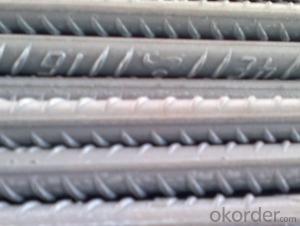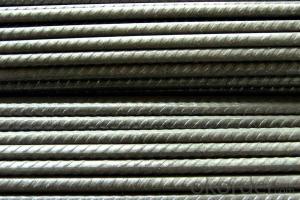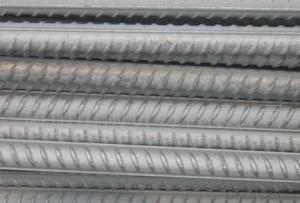High quality hot rolled deformed bar 6mm-50mm
- Loading Port:
- Tianjin
- Payment Terms:
- TT OR LC
- Min Order Qty:
- 25 m.t.
- Supply Capability:
- 20000000 m.t./month
OKorder Service Pledge
OKorder Financial Service
You Might Also Like
Product Description:
Product Description:
Specifications of HRB400 Deformed Steel Bar:
Standard | GB | HRB400 | |
Diameter | 6mm,8mm,10mm,12mm,14mm,16mm,18mm,20mm, 22mm,25mm,28mm,32mm,36mm,40mm,50mm | ||
Length | 6M, 9M,12M or as required | ||
Place of origin | Hebei, China mainland | ||
Advantages | exact size, regular package, chemical and mechanical properties are stable. | ||
Type | Hot rolled deformed steel bar | ||
Brand name | DRAGON | ||
Chemical Composition: (Please kindly find our chemistry of our material based on HRB500 as below for your information)
Grade | Technical data of the original chemical composition (%) | ||||||
C | Mn | Si | S | P | V | ||
HRB400 | ≤0.25 | ≤1.60 | ≤0.80 | ≤0.045 | ≤0.045 | 0.04-0.12 | |
Physical capability | |||||||
Yield Strength (N/cm²) | Tensile Strength (N/cm²) | Elongation (%) | |||||
≥400 | ≥570 | ≥14 | |||||
Theoretical weight and section area of each diameter as below for your information:
Diameter(mm) | Section area (mm²) | Mass(kg/m) | Weight of 12m bar(kg) |
6 | 28.27 | 0.222 | 2.664 |
8 | 50.27 | 0.395 | 4.74 |
10 | 78.54 | 0.617 | 7.404 |
12 | 113.1 | 0.888 | 10.656 |
14 | 153.9 | 1.21 | 14.52 |
16 | 201.1 | 1.58 | 18.96 |
18 | 254.5 | 2.00 | 24 |
20 | 314.2 | 2.47 | 29.64 |
22 | 380.1 | 2.98 | 35.76 |
25 | 490.9 | 3.85 | 46.2 |
28 | 615.8 | 4.83 | 57.96 |
32 | 804.2 | 6.31 | 75.72 |
36 | 1018 | 7.99 | 98.88 |
40 | 1257 | 9.87 | 118.44 |
50 | 1964 | 15.42 | 185.04 |
Usage and Applications of HRB400 Deformed Steel Bar:
Deformed bar is widely used in buildings, bridges, roads and other engineering construction. Big to highways, railways, bridges, culverts, tunnels, public facilities such as flood control, dam, small to housing construction, beam, column, wall and the foundation of the plate, deformed bar is an integral structure material. With the development of world economy and the vigorous development of infrastructure construction, real estate, the demand for deformed bar will be larger and larger..
Packaging & Delivery of HRB400 Deformed Steel Bar:
Packaging Detail: products are packed in bundle and then shipped by container or bulk vessel, deformed bar is usually naked strapping delivery, when storing, please pay attention to moisture proof. The performance of rust will produce adverse effect.
Each bundle weight: 2-3MT, or as required
Payment term: TT or L/C
Delivery Detail: within 45 days after received advanced payment or LC.
Label: to be specified by customer, generally, each bundle has 1-2 labels
Trade terms: FOB, CFR, CIF
- Q: How do steel rebars affect the overall cost-effectiveness of a structure?
- Steel rebars play a crucial role in enhancing the overall cost-effectiveness of a structure. These reinforcement bars are widely used in construction projects to provide strength, durability, and stability to concrete structures. By incorporating steel rebars, the lifespan of a structure is significantly increased, reducing the need for frequent repairs and maintenance, thereby lowering long-term costs. One of the key benefits of using steel rebars is their ability to reinforce concrete, making it capable of withstanding heavy loads and forces. This reinforcement prevents cracks and structural failures, ensuring the longevity of the structure. As a result, the need for costly repairs and replacements is minimized, resulting in cost savings over the lifespan of the structure. Moreover, steel rebars enhance the overall structural integrity of a building, reducing the risk of damage caused by natural disasters such as earthquakes and high winds. This increased resilience not only saves lives but also reduces the financial burden of rebuilding or repairing a damaged structure. In addition to their strength and durability, steel rebars provide cost-effectiveness during construction itself. These bars can be prefabricated off-site, allowing for efficient and streamlined construction processes. This reduces labor costs, accelerates construction timelines, and minimizes material wastage, leading to overall cost savings. Furthermore, steel rebars can be recycled, making them an environmentally friendly choice. The recycling process not only reduces the demand for raw materials but also lowers production costs, contributing to the cost-effectiveness of a structure. In summary, steel rebars enhance the cost-effectiveness of a structure by increasing its longevity, reducing maintenance and repair costs, improving resilience to natural disasters, optimizing construction processes, and promoting environmental sustainability. By incorporating steel rebars into construction projects, developers and owners can maximize the return on investment while ensuring the safety and longevity of the structure.
- Q: How do steel rebars help in preventing cracks in concrete?
- Steel rebars help in preventing cracks in concrete by providing reinforcement and added strength to the structure. When concrete is poured, it is strong in compression but weak in tension. This means that it can withstand forces that push or compress it, but it is more susceptible to cracking under pulling or bending forces. Steel rebars are embedded within the concrete to counteract this weakness. The rebars act as a framework, distributing the tensile forces throughout the concrete, preventing cracks from forming and spreading. They reinforce the structure, making it more resistant to bending, shearing, and other external forces. Moreover, steel rebars help in preventing cracks by enhancing the overall structural integrity of the concrete. When concrete undergoes shrinkage during the drying and curing process, it tends to crack. However, with the presence of rebars, the tensile forces caused by shrinkage are absorbed by the steel, reducing or eliminating the formation of cracks. In addition, steel rebars can also prevent cracks in concrete by providing resistance against temperature changes and external loads. They help to control the expansion and contraction of the concrete due to temperature fluctuations, minimizing the risk of cracking. Furthermore, rebars reinforce the concrete against heavy loads, such as those caused by traffic or seismic activity, ensuring that the structure remains intact and crack-free. Overall, steel rebars play a crucial role in preventing cracks in concrete by reinforcing the material, distributing forces, absorbing tensile stresses, and enhancing structural integrity. Their presence significantly improves the durability and longevity of concrete structures, making them more resistant to cracking and ensuring their stability over time.
- Q: What are the different methods of reinforcing concrete with steel rebars?
- There are several methods for reinforcing concrete with steel rebars. The most common method is to place the rebars in a grid pattern throughout the concrete structure. This can be done by tying the rebars together with wire or using rebar chairs to hold them in place. Another method is to use precast concrete elements with embedded rebars that are then connected together. Additionally, steel mesh or fiber reinforcement can be used to reinforce the concrete. These methods all help to improve the strength and durability of the concrete structure.
- Q: Can steel rebars be recycled?
- Yes, steel rebars can be recycled. Steel is a highly recyclable material and rebars made of steel can be melted down and reused in the production of new steel products. This not only conserves natural resources but also reduces waste and the environmental impact of steel production.
- Q: What is the purpose of steel rebars?
- Steel rebars serve the purpose of reinforcing and strengthening concrete structures. These rebars, also referred to as reinforcing bars, consist of steel rods or wires, which function as tension devices to provide extra strength to the concrete. By being embedded within the concrete, rebars aid in the even distribution of applied loads, thereby preventing the concrete from cracking or failing when under pressure. This reinforcement is particularly crucial in structures like buildings, bridges, and highways, which endure heavy loads or potential stress, as it enhances their durability and structural integrity. Due to their strength, durability, and resistance to corrosion, steel rebars are extensively utilized in construction projects. As an essential component, they ensure the long-term stability and safety of concrete structures.
- Q: How are steel rebars classified based on their diameter?
- Steel rebars are classified based on their diameter using a standardized system. The diameter of rebars is measured in millimeters and is denoted by a number. The most commonly used classification system for rebars is the "nominal diameter" system, where rebars are categorized into different sizes based on their diameter. The nominal diameter is expressed as a whole number, for example, 6, 8, 10, 12, etc. In this system, the nominal diameter represents the approximate diameter of the rebar in millimeters. For instance, a rebar with a nominal diameter of 8 has an approximate diameter of 8 millimeters. The diameter of rebars can range from as small as 6 millimeters to as large as 50 millimeters or more. It is important to note that the actual diameter of a rebar may vary slightly from its nominal diameter due to manufacturing tolerances. However, these variations are generally within an acceptable range. The classification of steel rebars based on their diameter is crucial in construction and engineering as it helps in determining the appropriate size and strength of rebars required for a specific application. Different diameters of rebars have different load-bearing capacities and are used accordingly in various structural elements such as beams, columns, slabs, and foundations. In summary, steel rebars are classified based on their diameter using a nominal diameter system, where the approximate diameter of the rebar is expressed as a whole number in millimeters. This classification aids in selecting the right size and strength of rebars for different construction purposes.
- Q: Can steel rebars be used in road construction projects?
- Yes, steel rebars can be used in road construction projects. They are commonly used as reinforcement in concrete structures, including roads and bridges, to enhance their strength and durability.
- Q: What is the role of steel rebars in preventing structural collapse?
- The role of steel rebars in preventing structural collapse is to provide reinforcement and strength to concrete structures. By being embedded within the concrete, rebars help distribute and withstand tensile forces, enhancing the overall structural integrity and preventing potential failures or collapses that could occur due to excessive loads or external factors.
- Q: What are the advantages of using epoxy-coated stainless steel rebars?
- There are several advantages of using epoxy-coated stainless steel rebars. Firstly, the epoxy coating provides an additional layer of protection to the stainless steel rebars, thereby enhancing their corrosion resistance. Stainless steel already possesses good corrosion resistance properties, but the epoxy coating acts as a barrier against moisture, chemicals, and other corrosive elements that may come in contact with the rebars. This helps to extend the service life of the rebars and ensures the long-term durability of the structure. Secondly, epoxy-coated stainless steel rebars offer improved bond strength with concrete. The epoxy coating creates a rough surface texture, which enhances the adhesion between the rebar and the concrete. This results in a stronger bond, increasing the overall structural integrity of the reinforced concrete. Another advantage is the ease of handling and installation. The epoxy coating provides a smooth surface, making it easier to handle and position the rebars during construction. Additionally, the coating reduces the risk of injury to workers as it eliminates the sharp edges that are typically associated with bare steel rebars. Furthermore, epoxy-coated stainless steel rebars are environmentally friendly. The epoxy coating is free from harmful substances such as lead and other heavy metals, which may be present in alternative coating materials. This makes them a sustainable choice, especially in projects that prioritize environmental considerations. Lastly, epoxy-coated stainless steel rebars require minimal maintenance. The epoxy coating provides a protective layer that reduces the need for frequent inspections and repairs. This not only saves time and costs but also minimizes disruptions to ongoing construction projects. In summary, the advantages of using epoxy-coated stainless steel rebars include enhanced corrosion resistance, improved bond strength, ease of handling and installation, environmental friendliness, and reduced maintenance requirements. These benefits make epoxy-coated stainless steel rebars a reliable and cost-effective choice for reinforcing concrete structures.
- Q: How do steel rebars affect the overall load-bearing capacity of a structure?
- Steel rebars greatly enhance the load-bearing capacity of a structure. These reinforcing bars are typically added to concrete structures, such as beams, columns, and slabs, to provide additional strength and durability. The primary function of rebars is to resist tensile forces, which concrete alone is not capable of doing effectively. By embedding steel rebars within the concrete, the overall load-bearing capacity of the structure increases significantly. When a load is applied to the structure, the rebars distribute the forces more evenly, preventing cracks and minimizing the risk of structural failure. This reinforcement increases the structure's ability to withstand heavy loads, including the weight of the building itself, live loads like furniture and occupants, and external forces such as wind and earthquakes. The rebars also help to control and limit the propagation of cracks within the concrete. Concrete is strong in compression but weak in tension, so without the presence of rebars, it would be prone to cracking under tensile stress. The rebars act as a reinforcement by absorbing some of the tensile forces, preventing the cracks from expanding and compromising the structure's overall strength. Moreover, steel rebars improve the ductility of the structure. Ductility refers to the ability of a material to deform without fracturing. When a structure experiences excessive loads or undergoes deformation due to external factors, the rebars help in absorbing and dissipating the energy, allowing the structure to deform in a controlled manner rather than abruptly collapsing. In summary, steel rebars significantly enhance the load-bearing capacity of a structure by providing tensile strength, preventing the propagation of cracks, and improving ductility. By reinforcing the concrete, rebars ensure the structure can withstand heavy loads, increasing its strength, durability, and overall safety.
Send your message to us
High quality hot rolled deformed bar 6mm-50mm
- Loading Port:
- Tianjin
- Payment Terms:
- TT OR LC
- Min Order Qty:
- 25 m.t.
- Supply Capability:
- 20000000 m.t./month
OKorder Service Pledge
OKorder Financial Service
Similar products
Hot products
Hot Searches
Related keywords




























